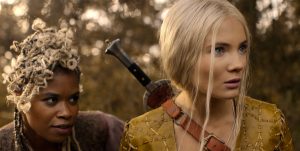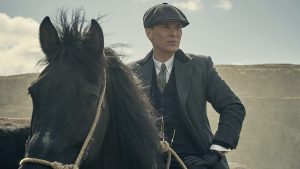
The following article contains spoilers for Vikings: Valhalla season 3.
It’s the end of an era: Vikings: Valhalla has passed on to the great medieval banquet in the sky. The Netflix series, a spinoff of the popular HISTORY Channel drama Vikings, catapulted the story several hundred years into the future to follow the stories of some of the most famous figures from the Icelandic legends and sagas. Full of epic battle sequences, a sprawling cast of characters, and a focus on the increasing tension between politics and religion, the series may have some dodgy bits when it comes to historical accuracy, but it’s certainly an exciting ride.
Netflix announced that the third season of Valhalla would be the series’ last earlier this year, though it doesn’t always feel as though this run of episodes was necessarily meant to serve as the show’s conclusion. Thankfully, whether this was always showrunner Jeb Stuart’s plan or not, Valhalla‘s final scenes are generally satisfying ones, as Leif (Sam Corlett) and his sister Freydis (Frida Gustavsson) sail off together the same way they initially arrived in the series’ pilot, with the promise of a literal new world on their horizon. Harald (Leo Suter) achieves his series-long dream of a crown, though it comes at a high personal cost. And England faces a succession crisis that will pave the way for both the end of the Viking era and the Norman conquest.
There’s an argument to be made that season 3 is a satisfactory ending for Valhalla’s story. After all, we’ve seen the formative events that helped forget these heroes of legend, and the rest of their stories are written as history. But it’s still difficult not to wish we’d gotten the chance to see some of their most famous moments play out onscreen.
Who Dies In the Vikings: Valhalla Season 3 Finale?
While Valhalla’s three main characters all survive season 3—though not without literal and figurative scars—the series finale has a rather substantial body count. A lot of the deaths this season are caused by the villainous Magnus Olafsson (Set Sjöstrand), who poisons the flour supply of Jomsborg in an attempt to wipe out Freydis and her people and murders some of his own men so he can fake a miracle and see his dead father Olaf canonized.
Elsewhere, King Canute (Bradley Freegard) shuffles off this mortal coil with his wife Queen Emma (Laura Berlin) at his side, and he’s the only character this season to get anything like a peaceful end. Canute’s first wife Aelfgifu (Pollyanna McIntosh), who served as her ex-husband’s regent in Norway for the better part of a decade, is killed by Magnus when he returns to Kattegut, though she at least gets a banger of a final line about how he will one day have to face a true Viking and learn what a brutal land it is that he’s trying to hold.
Magnus also kills Canute’s son Svein (Charlie O’Connor), who dies particularly violently, hoisted on a phalanx of spears. But while Svein’s pregnant wife is brutally threatened, she manages to escape with her life after promising to tell Magnus information about Freydis’s whereabouts.
King Sweyn Forkbeard (Søren Pilmark) wins the season’s “most ignominious death” award, smothered with a pillow by his own grandson Harald Harefoot (Ruben Lawless) after insisting the young man was too weak to do the deed.
Harald Sigurdsson Becomes Harald Hardrada
Harald spends most of Valhalla season 3 in exile, fighting battles across the Byzantine Empire and making himself indispensable to its Emperor, Romanos III. The leader of Constantinople’s elite Varangian guard, a mighty band of warriors from Northern Europe, Harald helps conquer Syracuse, feuds with Romanos’s most famous general, and amasses a fortune to help fund his campaign to claim the throne of Norway. Thrown into prison after being falsely accused of murder and rape, Harald fights his way free—but not before carving a very familiar name on the walls of his prison cell: “Harald Hardrada”.
History primarily remembers Harald Sigurdsson by this name. Roughly translated, “Hardrada” means “hard ruler” or “stern council”, and in the world of Valhalla it serves as a direct acknowledgment of how much of himself Harald has lost and/or been forced to sacrifice on his journey to the throne. From giving up Freydis and the son he’s never met to the friends who died for his mistakes in Constantinople, it’s evident that this Harald is a man who carries many griefs.
Harald ultimately returns to Norway, where he reunites with Leif before challenging his nephew Magnus’s claim to the throne. The Norwegian jarls strike a compromise, insisting that the family pair rule together, and both are crowned simultaneously. This partnership lasts until the end of the episode when Harald has Magnus seized and imprisoned. (In real life, they co-ruled for about a year until Magnus died.) Season 3 concludes with Harald reintroducing himself to his subjects and finally assuming the identity that comes to define him: Hardrada.
Leif Sets Out to Search For New Discoveries
Leif spends most of season 3 trying to figure out what’s next for him. Losing his sense of purpose while in Constantinople with Harald, he slowly begins his return north, driven by the idea of searching for a mysterious land he vaguely remembers from childhood. Gifted a ship by King Canute and armed with knowledge from the Greek mapmaker Calicinus, who believes in the existence of an undiscovered country, Leif is determined to head west until he finds the land he believes he saw when he was young, or possibly die trying.
Elsewhere, Freydis has arrived at a similar conclusion. Driven out of Jomsburg by Magnus, Freydis is eager to seek a new home for herself and her people. She too is determined to go further west, and to find the Golden Land her brother once spoke of with such conviction during their childhood. There, she believes, she and those like her can be happy, free to worship and live as they please. Though she and the Jomsborg survivors are waylaid in Greenland for a time by Erik’s selfish machinations—and his kidnapping of young Harald—Freydis remains convinced it is the place she saw in her vision and where she is meant to go as Keeper of the Faith.
Freydis Is Burned As A Witch — And Survives
The so-called Last Daughter of Uppsala goes through it in Valhalla season 3. During this run of episodes, Freydis is poisoned, sees half of the village of Jomsborg killed, returns to Greenland only to be beaten and imprisoned by her father, Erik the Red (Goran Visnjic), loses her son when his grandfather kidnaps him, and finds herself seized as a heretic by the militantly Christian Magnus and condemned to death. She is even dragged to a stake to be burned as a witch, though she’s rescued through the combined efforts of Harald and Leif, with whom she is finally reunited.
Thanks to Leif’s deft skill at setting fires, Freydis gets one last big moment to shine. Tied to a pyre she faces down Magnus and Harald sitting in judgment, insisting on her Viking gods’ supremacy as flames roar around her and the villagers of Kattegut scream in terror. It’s straight-up badass, and if Valhalla had to end it’s hard to imagine a more fitting final few moments for this character, who has served as its soul throughout.
While Freydis desperately wants to kill Magnus for everything he’s done to her and her people, Leif and Harald ultimately convince her to return to Greenland and find her son. That the season’s final shot also indirectly implies she’ll be continuing with her brother on his seafaring journey is an especially nice and meaningful touch.
Harald and Freydis Finally Reunite (But Not For Long)
After two seasons spent apart chasing their own destinies—Harald in Rus and Constantinople and Freydis in Jomsborg and Greenland—the star-crossed pair finally come face to face again in the Valhalla season 3 finale. Their interaction is swift and bittersweet as they argue once more about their conflicting worldviews—she wants justice for the Jomspeople Magnus killed, Harald wants to keep the peace as king—and she finally tells him about the son he’s never met.
The longing between the pair is evident but, yet again, the timing isn’t right for them to truly be together. He must rule Norway and figure out what kind of man achieving his lifelong dream has forced him to become. She must return to rescue young Harald and try to find a place where her people can practice their beliefs safety. Not all hope for their romance is lost, however, as the finale does hint at the possibility the two will find one another again when Harald is ready to meet his son—and reconnect with the man he used to be.
The Fate of the English Throne Is Thrown Into Turmoil
Despite his best efforts in life to prevent bloodshed, the death of King Canute kicks off something of a succession crisis in England. Though the king explicitly declared that his wife Queen Emma should rule after him, ostensibly until his sons get some more political experience under their belts, almost no one follows his orders once Canute isn’t around to enforce them. (The first rule of Valhalla is apparently that everyone lies.)
Emma summons Edward, her eldest son from her marriage to Aethelred, to return home from Normandy in an attempt to get the English nobles back on her side, but her message never reaches France. Earl Godwin (David Oakes), who made Canute a personal deathbed promise to support Emma’s rule, immediately breaks his word and abandons her cause. He instead backs Harald Harefoot, the king’s son with Aelfgifu, who previously murdered his own grandfather, Forkbeard, in the hopes of making himself a more appealing candidate for the crown.
Some of you may be relieved to know that although the finale ends with Emma making flirtatious overtures toward her stepson in an attempt to preserve her power, there’s no historical source for that particular bit of political calculation. (Though within the world of the TV show, it’s certainly a reminder of how far Emma’s willing to go to hold power in whatever way she can.) The real Harefoot only reigned for five years before being succeeded by Canute’s son Harthacanute, who died himself just two years later. None of Canute’s children lived longer than a decade after their father’s death.
Meet the Kids Who Will Fight at the Battle of Hastings
One of the best things about Vikings: Valhalla has always been the sly way the show winks toward the history we all know is coming. Last season, Earl Godwin’s wife, Gytha, had a child whose name you might recognize: Harold Godwinson, who will one day grow up to be the last Anglo-Saxon king of England. In season 3, we meet his ultimate adversary, a young William of Normandy.
A descendant of the infamous Rollo (yes, the same man from the original Vikings series), he’s depicted as thoughtful and incredibly politically savvy for his age, so much so that even Canute takes notice of him and his skills as a potential leader. William of Normandy, of course, was renamed William the Conqueror when he defeated Harold Godwinson at the Battle of Hastings in 1066 and became one of England’s most famous kings.
Beyond Valhalla: What Season 3 Didn’t Cover
Though season 3 is Valhalla’s last, the show’s final hour feels more than a little incomplete. Part of that is because the series concludes before we get to witness some of the biggest moments we know still lie ahead for these characters—rightly or wrongly, many viewers had likely assumed the show would tell the story of the end of the Viking Age all the way through to its conclusion. Instead, it stops at what feels like a fairly arbitrary point in both European history and in the stories of Leif, Freydis, and Harald, as many of the most significant moments of their lives are still to come.
As most likely already know, Leif Erikson did find the land of his visions, becoming the first European to set foot on continental America. According to the sagas, his sister Freydis also helped explore the new world—though her experiences there vary widely depending on which version of her story you read. (And some of them don’t reflect particularly well on her.)
Harald’s story is a bit more complicated. King Harald III ruled Norway for twenty years of relative peace and prosperity, though he also spent most of it insisting on his right to the throne of Denmark. (A claim that he never achieved.) In the fall of 1066, he amassed over 300 longships and attempted to invade England, ultimately suffering a crushing defeat at the Battle of Stamford Bridge that wiped out almost his entire army. Harald himself was killed during the fighting and his death is considered by many historians to be the unofficial end of the Viking Age.
As for England, the crown ultimately passed to Emma’s eldest son, Edward, who went on to rule for the better part of two decades as Edward the Confessor before dying without any children. (He was canonized after his death, so not a total loss for him.) He was succeeded by Harold Godwinson, son of the Earl of Wessex, whose lifetime of scheming and betrayal finally paid off with a literal crown for his child. (Who, admittedly, did have royal blood in his veins thanks to Gytha.) But although Harold would go on to defeat Harald Hardrada’s army at the Battle of Stamford Bridge, Godwinson himself would lose his life and his crown just three weeks later, when Wiliam of Normandy defeated him at the Battle of Hastings and changed the course of English history forever.
Wouldn’t all that have made for some excellent TV?
The post Vikings: Valhalla Season 3 Ending Explained appeared first on Den of Geek.









